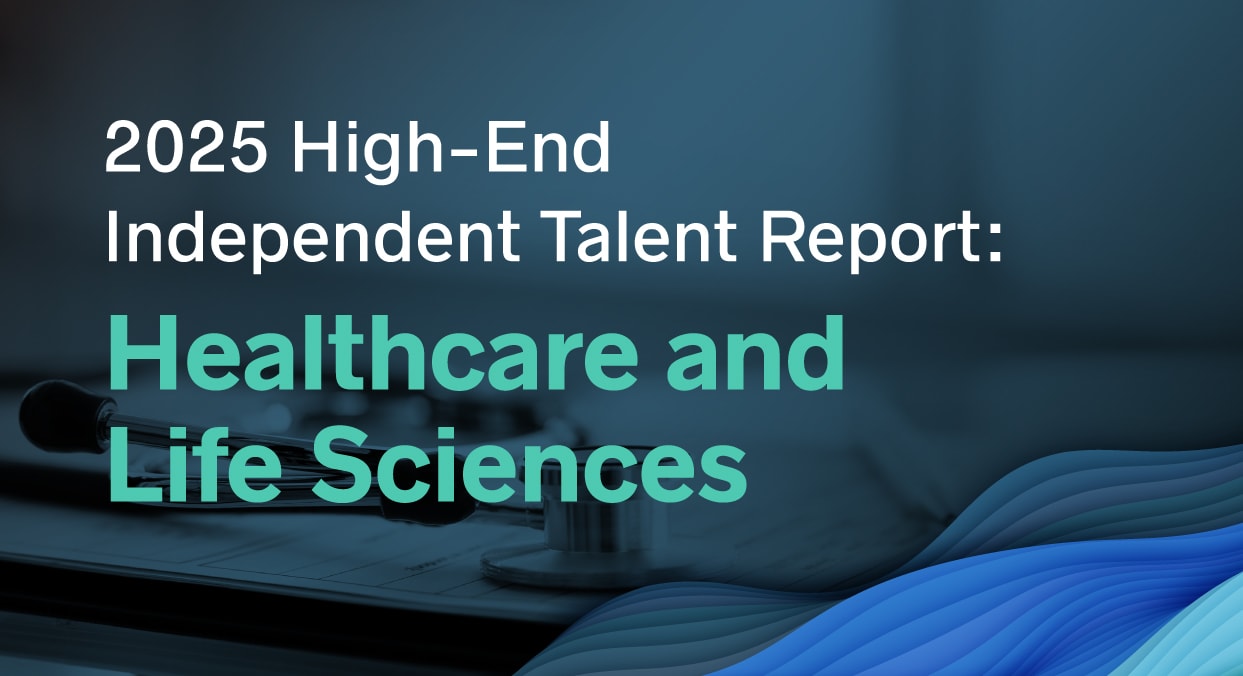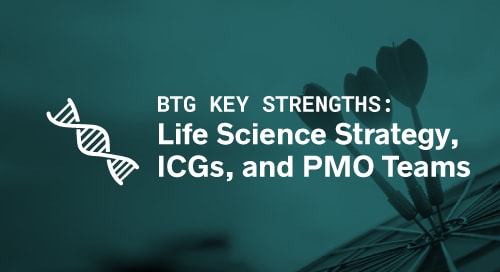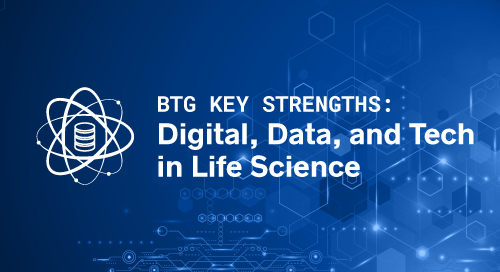For now, the world’s eyes are trained on the pharma and biopharma researchers who are racing to develop vaccines and therapies for COVID-19. Yet in order to ensure success in the market—to say nothing of long-term profitability—commercial leaders must prepare now for the launch of these new products.
In the latest episode of our podcast, BTG Insights on Demand, independent biopharma consultant Marc Cooley—who helps companies bring commercial planning efforts into the R&D process—joins Business Talent Group’s Leah Hoffmann to discuss the commercial considerations that life science companies should keep in mind as they develop COVID-19 vaccines and therapies.
Marc has also generously offered to provide pro bono marketing and strategy consulting services for companies and organizations working on treatments or vaccines for the management of COVID-19. Learn More
Listen to the podcast to hear Marc’s advice. You can also read our lightly edited transcript of the chat below.
There are dozens of projects around the world that are aimed at developing vaccines and therapies for COVID-19. Let’s set the stage by talking about the role that commercial functions typically play during the development of pandemic treatments.
Well, the commercial function is obviously a different role during a pandemic, but it goes alongside R&D. You’re trying to work in collaboration as a lot of things happen on a tremendously shortened timeline—and with a lot of pressure from outside sources. From the commercial side, it’s about making sure that the products being developed are going to have value not only once they make it through development, but also later on.
What’s tended to happen in the past is, in typical development programs, commercial was on the sidelines, and nobody would come to them except for forecasting. But what people are starting to realize is that there’s a connection between failed launches and a lack commercial involvement. And the more that companies can integrate commercial leaders into the R&D process, the greater the success of the product.
For these types of products, there is certainly the short-term focus of addressing the pandemic, but also the investment perception in terms of where it goes in the future and whether there’s going to be long-term market viability.
What’s unique about developing therapies during pandemics?
Well, there’s quite a bit. Number one is that it goes against basically all of the so-called commercial rules. For one thing, as I mentioned, you have the significant pressure that’s on the organizations that choose to become involved. Typically, there might not be a lot of interest in these therapies in normal circumstances, because the risk, especially with vaccines, is so great.
Now when you start to put a pandemic situation on top of that, you’re not going to have a lot of control on price or where you’re going to distribute things to. It may all be dictated purely by the government. So there’s something to be said for these organizations that are out there trying to pursue pandemic therapies. Certainly it will help their name, but to be the one who’s actually going to come out with a vaccine, say, is to take on quite a challenge.
It’s definitely a risk, though I saw a survey that suggested the pandemic has begun to change the public perception of the pharma industry, which, at least in the U.S., was not great to begin with. But to continue with commercialization for a moment, how does the COVID-19 pandemic differ from previous ones?
It comes down to noise, and that’s both good and bad. The good is that we’re raising awareness of the likelihood of these pandemics—as everyone should know by now, this isn’t the first pandemic, and if there’s one thing I can predict, it won’t be the last.
The media pickup has also helped in terms of increasing compliance with countermeasures, with stay-at-home orders and social distancing. We’re probably a little bit late to the table, some people will argue, but at least those measures are taking place, and we’re getting experienced, which is probably the most valuable asset here, for the future.
On the not-so-good side, I think what was underestimated is the impact of aggressive news media, social networking, and things of that nature in terms of fueling panic and confusion from the public. That always makes it harder to manage something that requires so much leadership and organization. There’ve been a lot of confusing things in terms of wearing face masks and whether ventilators are necessary and so on. I know it’s exciting, but we’ve got to take responsibility here across all stakeholders in terms of wanting to make sure things go in the way that they need to go.
What are some of the challenges, both in general and that you think will impact this specific pandemic, that the commercial team should consider as they develop COVID-19 therapies and diagnostic tools and vaccines?
It’s probably helpful to put yourself in the mindset of a commercial leader at this point in time. R&D is running the show, and it’s very close to the highest leadership level in the organization, so commercial tends to take a back seat. But we know that high expectations are going to be put on us, not only in terms of how we address product flow, distribution, and things like that, but also later on. There’s going to be a lot of investment in terms of manufacturing resources, so from a commercial standpoint, we need to be thinking about making sure these products are going to be viable for the future.
First and foremost, that means managing expectations, and that gets into communication, which I think is core across all levels of leadership systems. There’s so much demand out there—so much frantic demand—and we need to manage expectation around that. With vaccines, there are also a lot of expectations to be managed in terms of how they’re going to be handled, stored, and who’s going to administer them.
Unfortunately, in this situation, it’s not just “come and get it.” The government takes on a big role in terms of who gets them and when and how, and they start to prioritize through public health emergency countermeasures. They work through the companies in terms of distribution of the vaccine and making sure all the logistical planning is in place.
From a commercial standpoint, you can get involved with this early on by making sure everything can be communicated. “How should this be used? How should it be handled? Are there things that can be done to make sure it’s all done easier, understanding that this is going to be done on such a massive scale?”
So it’s just thinking like a good marketer—what will the needs and objectives be for your audience? And then the last one everybody wants to talk about is price. This is something that I think is probably being exaggerated. You mentioned that the industry might get a good rep, but people are also putting forth comments about how this is a great time to take advantage of the situation, and that’s absolutely not true. It would be a death sentence for any company that tried to do that.
This is about human life now and about being in it together. It’s one of the, if I may say, blessings with regards to a pandemic, it does bring people together. And pricing is a discussion that goes on between the highest level in the organization and the government, and the government does certainly respect that there is a little bit of profit that needs to be made to cover development costs, but that’s not really controlled at the company level and they’re certainly not going to make it where it’s going to be inaccessible to people, which is still important.
You brought up risk earlier, and I’d like to talk a little more about the trade-offs. There’s a lot of risk involved with developing therapies for the pandemic, and yet a potentially very valuable outcome to the brands that are successful.
Yes. I am focusing more on the vaccines, because they’re more complex, but the diagnostics are equally as important, so let me just speak a second to them. Diagnostics are so, so essential because they’re the ones that actually identify who those targets are that we need to get out of the public exposure. Unfortunately, as you’ve heard in this situation, that’s a case where we had to wait for quite some time. By the time we did get things going, people were exposed to other people and so on.
But the vaccines probably take on a bigger role in terms of resolving a pandemic, because now you’re getting to the people who haven’t been exposed and preventing them from getting the exposure. But these products, a lot of them are being developed with entirely new technologies. The RNA vaccines are a whole new area, and they’re the ones that are leading the timeline right now with COVID-19.
So it’s going to be interesting. There is data about immunogenicity, but we don’t know, when you’re dealing with the genetic aspects of that, how these vaccines are going to function when they start to get out there in these large patient populations. And that’s one of the complexities of vaccines—you have to inject something into people who are otherwise healthy and find out if it can, number one, do its job in terms of invoking an immune response, but also not add on any threats or safety issues. That’s why vaccines require a large, large number of people to study, and it takes time, because a lot of these vaccines—flu is a great example, and it’s one that I’ve spent most of my career around—it changes. You have therapies that come out one, but then, all of a sudden, those bugs are able to form different defenses against the vaccine. So you can see where all that kind of plays through.
Then you get into manufacturing side of things. The good news is that the newer technologies, the RNA and other vaccines that are being developed, they’re shortening that timeframe. Now you can actually produce these things much more quickly, but then you have to obviously get your manufacturing geared up, and now we’re talking billions of doses, which can take quite some time.
Can we touch a little bit more on that, managing supply and demand? There’s going to be, as you’ve mentioned, a huge demand. Whether it’s the world’s population or even just 10%—that’s a lot of resources.
Yes, incredibly, and that’s why another interesting aspect of this and why you have so many companies willing to go into it even after the fact, is that you’re going to require multiple products in a situation like this, and that’s why there’s no reason for one company not to. The demand will be so great. One of the interesting aspects of a pandemic situation, this might get a little bit not politically correct, but it’s true. In this situation, the borders become very tight in terms of who gets the vaccine and who doesn’t.
For example, in the United States, for the United States companies, the government’s orientation is to get everyone in the United States vaccinated. So now you have this situation where vaccine companies are very limited and typically very globally orientated, now they’re restricted in this particular situation to first and foremost, keeping it within the borders of the country. So that’s one area in terms of controlling that, who gets it and how.
But having been involved in some advisory meetings on pandemic planning, I can tell you that, even within the country, there’s different levels. Obviously, your healthcare workers, your police and your military—the people that maintain the order and health and everything else—are going to be a top priority.
Then you’re going to go to your at-risk people, your people who are at highest risk of developing mortality, which would be your immunocompromised individuals, your elderly people, things of that nature, and all of that is kind of mapped out through those planning processes that are in place.
What are some of the key strategic areas that commercial teams should start preparing for now? We’ve got pricing, we’ve got all the supply and demand issues—there are a lot of things on their plate.
Yes, that’s a good question. For the pandemic and through the reaction to the pandemic, a lot of those things automatically go up the ladder—pricing and things like that. But going back to that commercial person’s role, let’s say that they know that after this is over, management is going to come to them and say, "Okay, what are we going to do in terms of can we take this vaccine now and create an actual product going forward with it?"
That actually is a whole different market in itself, which we’ve seen with the flu vaccines. Number one, I think you have to understand that as humans are quite fickle, and we quickly forget things. One of the interesting things we’ve found that I’ll share with you in the flu vaccines is that after past pandemics, the most recent one being 2009, within two years, we’re already back to pre-pandemic vaccination levels in terms of coverage. Children and the elderly are always kept pretty high in terms of vaccination, but adults very quickly go right back and we’re back down to 20%, 30% being vaccinated.
That’s one area from a commercial standpoint, so how do you uphold demand? That’s demand in terms of getting the vaccine each year, demand in terms of stockpiling—because for actual specific pandemic vaccine products in the future—stockpiling exercises go on between government and manufacturing, so that you have to make sure that you’re involved with those contracts.
Obviously, when you’re dealing with government tendering, you’re dealing with very much more restrictive pricing, so you need to make sure that you can maintain some sort of profitability based on that risk. These factors are why a lot of companies don’t get involved with vaccines. But there are opportunities with that as well in terms of working with the government and making sure that you’re there to assist, and they do their part as well in making sure that the companies are fully resourced to do what they need to do.
Then the last thing is that you have to look at differentiating your product. If you have a vaccine now, you should be starting to think about, “Okay, if in the future when we have this, obviously we’re going to probably have a COVID, or I should say a SARS vaccine on an annual basis.” So you’ve already got some talk of combination with flu, and that’s easier said than done. But are there other things that you can do maybe through patches, maybe through the way it’s administered, there’s all different types of things, and only the entrepreneurial marketing people will make it successful doing that kind of thinking.
There’s been a lot of talk about the changes people are making because of the pandemic—the way that the stay-at-home orders that are in place for many of us will have long-term impacts on the way we purchase and interact with each other. Do you expect that to have an impact on the life science industry? Telemedicine is one thing, but something like patches could be sent directly to consumers, right?
That’s a great point. Anything that’s this big is going to change the normal course of effort out there in terms of how things are done, and it can be good and bad. I think if you have the right mindset, an entrepreneurial mindset, you think, “All right, so then how can we make that work for us?”
There’s a lot of concern about the whole idea of what’s going to happen now with measles. Many kids are not getting their vaccines because of this situation, which means we may have a resurgence of measles in the US. As you’ve probably heard, we’ve already started to get those in pockets. And now you have all the other vaccines that are not being used, and a lot of making up to do, so how are companies going to make sure that people can get their products? I sense that pharmacies are starting to get involved with this—pharmacies are going to have to play a much, much bigger role now in getting everything caught up. And, as you know, once people do that and get comfortable with it, then it starts to take on its own life and continue to progress.
Get the Skills You Need
Thousands of independent consultants, subject matter experts, project managers, and interim executives are ready to help address your biggest business opportunities.
About the Author
More Content by Leah Hoffmann





















